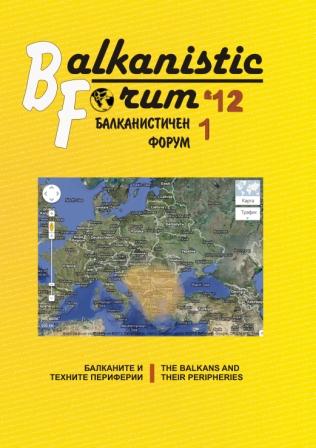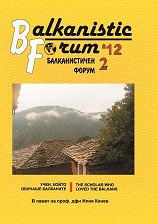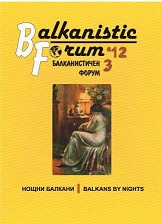
We kindly inform you that, as long as the subject affiliation of our 300.000+ articles is in progress, you might get unsufficient or no results on your third level or second level search. In this case, please broaden your search criteria.


This text discusses the activities of the Department for Macedonian-Balkan Literary- Historical Relations which was established in 1989 at the Institute for Macedonian Literature, Sts Cyril and Metodij University of Skopje. It analyzes the work of the Department that consists of project researches on the contacts and the relations between the Macedonian and the other Balkan literatures, and the points of contact between the Balkan literatures on typological, literary-historical and ideological level, as well as of the aspects of the cultural pluralism and the intercultural connections in Balkan literatures.
More...
In the article the development of the system of the high education in Turkey from the end of the 20th and the beginning of the 21th century as a philosophy and practice has been considered. The reform of the Turkish high education is a result of both the economic conditions and the change of the traditional European University model into an American model based on the market principle (.Market Model University.). The author considers the basic documents and strategies of the development of the science and high education reflecting this change and the foreseen perspectives. A conclusion was made that the development of the high education in Turkey is connected with the interrelations between science, technologies and industry.
More...
The observations on the personal names (native ones and borrowed from Arab and Turk languages) of the Bulgarian Muslims from the town of Smolyan and the region have been represented. The research is based on the anthroponomy material collected for the elaboration of “Frequency Dictionary of the Personal Names in the Smolyan Rregion) covering a 100 years period (1913-2009) and including about 4400 names.
More...
The present article is focused on some key moments in шге history of Suleymaniye, its social and educational activity, religious beliefs and secret practices. The main aim of the article is to provide the Bulgarian scholars working on the problems of social integration of ethnical and religious communities and the teachers engaged in the education of children stemming from similar groups, with correct information about the history and doctrines of this Turkish Neo Sufi community.
More...
Prof. Dr. Ilija Konev left great cultural legacy for us. Systematically going forward step by step he had been elaborating the conception of development and interrelationships of the Balcanistic and Central-European literatures and cultures. He usually took Bulgarian literature as starting point in his analysis, but in the end he gave a whole picture about national and universal characteristics of literature and art of almost every national culture in the Central European and Balkan region. This approach itself implicitly embraces the studying of relations between national characteristics and the universal human values. As a result Ilija Konev arrived at the conclusion that the free development of the national cultural characteristics in the Balkan region led to the strengthening of the universal human values. And there were not any contradiction between them.
More...
The paper considers the problem of the past and its role in building identities according to the case study from the Hungarian Middle Ages history and its reflection on the present time. It is well known that the today’s inhabitants of the Greater Cumania/Nagykunság and Little Cumania/ Kiskunság regions in Hungary are related by their origin and tradition to the Cumans – vanished nomadic people. I trace two lineages: the first – the collective memory for the nomadic past, preserved within regional culture and the second – the memory carried in words. Particular attention is paid to the processes of interaction between group memory and historical memory, “longue durée” and historicity as well as – to the inventing nature of tradition.
More...
In the article I consider the comparative method of Ilija Konev rooted in the traditions of Ivan Shishmanov. The basic aspects of the four volume research “The Bulgarian Revival and Enlightenment” have been commented as a brightest illustration of the scientific position and comparative methodology of the author. The thesis that Ilija Konev succeeded to found a specific comparative school in the Bulgarian and Balkan studies have been defended.
More...
The article considers the problem of the definite article in the Slovenian dialects. The author examines the distribution and the common usages of ta on the Slovene-speaking territory. In spite of the fact that the definite article developed from a demonstrative pronoun, in the colloquial Slovenian it differs in many respects from the definite article in German, which indicates that the definite article is a result of an original development of the Slovenian language, not a result of a foreign influence.
More...
The paper presents the frequency of use of the more common anthroponyms from Greek origin in part of the municipalities in the Smolyan region for all the decades during a 100-year period, as well as the spreading and the semantics of some rarer anthroponyms. The author considers the variations and presents the word-formation chains of these anthroponyms with more productive formants.
More...


This article examines the street as a stage act of speech. The following examples from the dialects of the different Bulgarian communities in Albania are considered: Gora, Golo borda, Prespa. Conclusions are made about specific acts of markers of regional dialectal code and about the interference between Bulgarian language and Albanian language.
More...


Following the essay of Konstantin Kristoforidhi, in the year 1863 due to informative purposes the British Bible Society delegated Alexander Thompson (the British Bible Society representative in the Ottoman Empire 1860-1896) to visit Albanian lands. Thompson was a polyglot and a linguist, who in particular studied the dialects of Albanian language. While visiting Bosnia province, amongst others he met the governor of a city to whom he presented the publications of British Bible Society.
More...
The author comments the Bulgarian dream- books from 19th century as a possible optic for researching of the Balkan values and common cultural models. A special attention is paid to the dreams of father Neophyte Rilsky documented in his diary.
More...
The author deals with the educational process of the Bulgarian youngsters in Germany emphasizing three different and important periods named as “the first youth migration flux in Germany”, “students behind the wall” and “students without visas” related to the fatal years: 1878, 1944, 1989. It is interesting that the students’ attitude to education and to the aims of studding were different for the different periods. It turned out that studding in the period after the Liberation freed the potential, shaped the interests and the new world view of the Bulgarians the most prominent example being the study of Prof. Ivan Shishmanov. The education in the period 1944-1989 was marked by certain discomfort for the Bulgarian young people divided between East and West Germany. On the other side, after 1989 a second powerful flux of students to Germany.
More...
The article comments the theme about the night in the Serbian and Croatian literature of the 19th century. On one hand, the night is innermost and it gives the subject tranquility and exotic he needs. On the other hand, it is mysterious, it`s filled with visions and stories that are fantastic and they force the person to trembles in the face of unexpected. In other poetical works is interpreted the theme of liberations wars, the night is necessary – this is the time when the heroes can hide and can attack their foes and in the morning will begin new era in history of their native land. The authors, who consider the night in their works, are guided by their feelings, emotions and philosophical reflections on the life and the existential human issues. They succeed to create a picture in which the night is in line with the ideas and emotions of each of their characters and themselves. And this night – intimate, mysterious or necessary – is interesting and contradictory recreated.
More...
The authors represent the night life in the small town of Gorna Dzhumaja (Blagoevgrad) during the time after the First World War. By that time the town is a settlement of about 10 000 inhabitants. Different sides of the .evening. and .night. lives: streets, square, city park, cinema, Military Club, restaurants. As a .dark side of the moon. there was the underground - the brothels.
More...